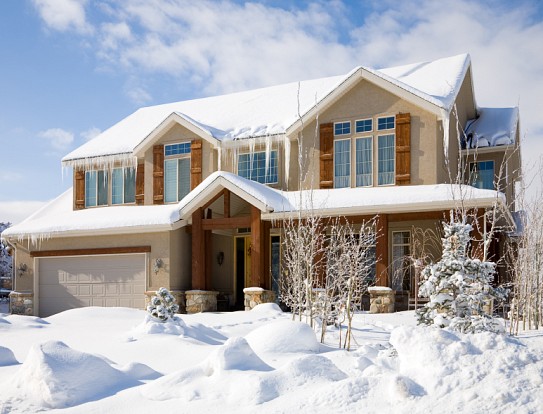Myths and Facts About Snow and Your Home

1. MYTH: The icicles hanging from the roof are so pretty!
FACT: Besides the fact that when icicles start to melt they may fall on your car -- or worse, you! – they are a warning signal of ice dams, one of the most damaging things that can happen to your house. Ice dams are formed when warm air escapes from your attic, due to insufficient insulation. As snow melts from the warm air, water drips to the eaves (where it is colder) and freezes – creating a dam. Ice dams can cause heavy damage to your roofing material and gutters, as well as below the roof from the "avalanche effect" should temperatures rise suddenly.
Prepare ahead of time; if you have gutters, be sure they are cleaned out before winter sets in. The best winter roofing situation is to have enough insulation in your attic to create a layer of air between insulation and roof that is the same temperature inside and out. Avoid chipping away at ice from the ground.
Roofing materials can make a difference in the creation of ice dams. Asphalt shingles are more prone to ice dams. They have a rough surface and will hold onto snow until it trickles off or evaporates. Metal roofing, especially if there is a PVC coating, is designed to allow snow to slide off more easily due to the smoother surface. You can also install snow guards or heating cables to metal roofing to further avoid ice dams.
2. MYTH: I have a newish home; I shouldn't have anything to worry about when it snows.
FACT: Ah, if only that were true. However, homes built before 2010 were not subject to state energy efficiency building codes. So, unless you built your home yourself and you are highly invested in energy efficiency, it's a good idea to remain aware of possible problems during heavy snowfalls.
3. MYTH: Solar panels won't work when it snows.
FACT: Solar panels will still work following light snow. If you have a heavy snowfall, they may not generate electricity for a short time. However, due to the slick, angled, and often black surface of solar panels, the snow will slide off in fairly short order. If you are very concerned about this potential problem, have your solar panels installed on the ground. Solar panels installed on the ground are more steeply angled than roof panels.
4. MYTH: Snow on the roof is just a fact of life in winter.
FACT: While a certain amount of snow on your roof will act as insulation, too much can cause collapse, leaks, or damage when the snow slides off the roof onto whatever is below. However, if you experience heavy and/or frequent snowfall, you may need to take measures to remove snow from your roof if the layer is more than two feet deep.
It can be tricky and dangerous to remove snow from a roof. For low roofs, you can work from the ground, using a snow rake. Otherwise, you may want to hire a professional. Check for any sagging in your roof via a trip to the attic. If the roof is sagging, get expert help as soon as possible.
5. MYTH: A generous sprinkling of snow melt is the best way to deal with snow on your property.
FACT: Snow melt products can damage your home. Snow melt products create a faster freeze/thaw cycle, which might crack concrete and asphalt. Since concrete is porous, the corrosive damage from salt water adds to the potential damage over time. The actual chemicals themselves are toxic to plants and animals. Rock salt and halite are the most damaging, followed by calcium chloride.
Alternative green products are sand, kitty litter, or Warm Paw. Other products which are much more expensive, but are safe for the environment and pets, are Propellant 49 and a variety of liquid deicers that also require the purchase of a sprayer for the product.
Updated February 22, 2018.
Looking for a Pro? Call us (866) 441-6648

Electrical Average Costs
Electricians Experiences

Roof Repair To Keep Out Miami Rainstorms

Local Handyman Fixes Fence Damaged By Jacksonville Summer Storm



